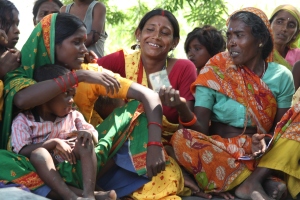While researching mobile financial services (MFS) best practices, Grameen Foundation had an opportunity in August to visit Tujijenge Microfinance, a microfinance institution (MFI) in Tanzania. At the time of the visit, it was the only MFI in the country that had implemented MFS, and used it for more than two years, reaching one-third of their clients (5,000 people) with noted impact in institutional growth. It has used MFS for collection, both savings and loans.

Debora is a client of Tujijenge and serves as treasurer for her loan group. She sends repayments for the group using M-Pesa on her mobile phone.
Although MFS has been successful in Tujijenge, there are key lessons to be learned from this implementation. What was evident from the study was that customer awareness and training is key. Tujijenge did invest a lot of time training clients, conducting training at each group meeting, and creating informational pamphlets with simple language. Literacy levels in Tanzania are quite low, leaving a question over the success of the training and pamphlets, and whether clients had to struggle to understand the product, which would affect how easily and quickly they trusted the system.
The MFI’s staff are happy with the initiative. However, they are challenged by the down-times by the Mobile Network Operators’ system and the low literacy levels of most of their clients, which means they must spend a lot of time helping clients send their repayment. This close assistance can lead to fraud, as a loan officer may send money to his or her own phone account or to a wrong account, intentionally or accidentally. One way of mitigating this risk involves proper client training and awareness.
Another challenge involves the country’s financial regulator, the Central Bank of Tanzania, which regulates the amount that the e-wallet can hold per day. Each SIM card can only send a fixed amount of e-money per day and the transaction cost for loan disbursement is fixed at 1% of the value disbursed to the client. Due to these limitations, Tujijenge is not actively using mobile for disbursement.
Additionally, we have learned is that it is important to peg an MFI’s key performance indicators to any incentive scheme for staff, to motivate staff to enroll more clients into using the system when an MFI is rolling out MFS.
We’ve seen that market research is key to implementing mobile. MFIs interested in implementing such a program should always visit other regions where MFS is working, and do their own research, to familiarize themselves and contextualize how MFS works. “Copy and paste” never works! Remember that a different environment will always offer its own unique circumstances.
Finally, manage your expectations when rolling out an MFS solution. Tujijenge expected that many clients would be interested, but discovered many pitfalls after the pilot because it did not conduct enough market research prior to implementation, and so lacked information.





